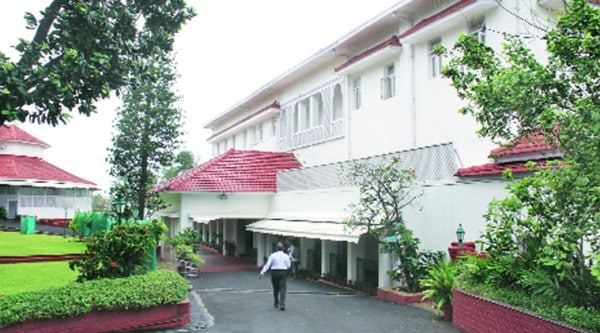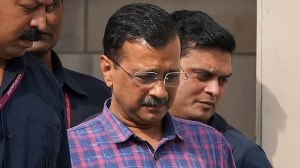- India
- International
A relic of Raj, the ‘queen’ of Raj Bhavans still sits pretty by sea
Nestled in forest where peacocks stroll, Raj Bhavan comprises a cluster of seven 19th and 20th century bungalows and a private beach.
 A staff of 200 maintains the precinct that has a lawn that can host around 1000 people, a heliport, swimming pool, a badminton and tennis court, a gymnasium and a club house. Most of it is yet to be discovered by the new Governor C Vidyasagar Rao who took over a month ago.
A staff of 200 maintains the precinct that has a lawn that can host around 1000 people, a heliport, swimming pool, a badminton and tennis court, a gymnasium and a club house. Most of it is yet to be discovered by the new Governor C Vidyasagar Rao who took over a month ago.
Surrounded by a mile-long forest where peacocks stroll, a private beach, a cluster of seven bungalows constructed between the 19th and 20th century in a circle is what forms the heritage precinct of Raj Bhavan at Walkeshwar.
From French furniture brought by the then Governor Mountstuart Elphinstone in 1820s to the late 19th century Iranian painting of a princess and the 11th century sandstone sculpture of Shiva Parvati, besides the heritage bungalows, the walls and corridors of the Raj Bhavan are a treasure trove of ancient artefacts.
In 1880, Sir Richard Temple had initiated the formal transfer of the government house from Parel to Malabar Point, according to Raj Bhavan archives. The early residence and office was known as Marine Villa and the current Raj Bhavan, spread over 50 acres of peninsular land, is built on and around this villa.
The official residence of the Governor, Jal Bhushan, was built on the foundation of “pretty cottage” where Governor Elphinstone had lived. In the 19th century, Reginald Heber, an English clergyman and traveller, described Jal Bhushan as, “a pretty cottage on a rocky and woody promontory actually washed by sea spray”.
Now, portraits of Maratha chieftains Trimbakrao Kurundwadkar and Luxumanrao Mahadeo painted by Theodore Jenson in 1866 adorn the walls of the waiting hall, while Elphinstone’s French furniture with miniature portraits on the backrest still enjoy a distinct place inside the Governor’s office.

Raj Bhavan officials claim that American writer Mark Twain lunched with the then Governor Lord Sandhurst in 1896 in the dining room of Jal Bhushan.
The biggest dining room in the premises, Jal Vihar or Banquet Hall, is said to be in the only building that retains its original colonial interiors. The hall can seat 48 diners at a time and is separated from a large ball room on the northern side by intricately-carved Madras wooden jails from the 19th century.
A map of Maharashtra was first unveiled on the Raj Bhavan premises, right outside the banquet hall, by the then Prime Minister Jawaharlal Nehru and then chief minister Yashwantrao Chavan on May 1, 1960. Since then, swearing-in ceremonies of Maharashtra Governors take place at the Durbar Hall or Jal Sabhagriha, which has stately columns at the entrance. The hall was designed by George Wittet, renowned for designing Prince of Wales Museum and the Gateway of India. “The last durbar was held in 1939 and attended by several Maratha sardars,” says Sadashiv Gorakshkar, former director of the Chhatrapati Shivaji Vastu Sangrahalaya and author of Raj Bhavans in Maharashtra.
The next four buildings are spacious bungalows — Jal Laxan, Jal Kiran and Jal Chintan, Bay Bungalow — where President, Prime Minister, Vice-President, Chief Justice of India and other eminent guests of the state stay during visits to Mumbai.
The foremost bungalow that rests precariously on a single rock on the southernmost tip is the Jal Chintan or Point Bungalow. “This was the only bungalow at Malabar Point until Evan Nepean built his own cottage, the Jal Laxan,” says Gorakshkar. The bungalow with its uninterrupted view of the Arabian Sea and the Prong’s Lighthouse was the preferred guest house of prime ministers Nehru, Indira Gandhi, say Raj Bhavan officials.
“There is so much history in these walls, before, during and after Independence,” says K Sankaranarayanan, who served as the state Governor for four years before demitting office recently.
The location and uniqueness of Mumbai’s Raj Bhavan alone justifies its claim of being the “Queen” of Raj Bhavans, says K Sankaranarayanan.
A staff of 200 maintains the precinct that has a lawn that can host around 1000 people, a heliport, swimming pool, a badminton and tennis court, a gymnasium and a club house. Most of it is yet to be discovered by the new Governor C Vidyasagar Rao who took over a month ago.
Rao had decided that the sunset point at the edge of the property overlooking the Arabian Sea is his favourite spot in the precinct. “The view is breathtaking and there is so much heritage inside this complex. It is thrilling to be part of this historical precinct,” he says.
Must Read
Apr 23: Latest News
- 01
- 02
- 03
- 04
- 05






































